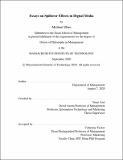| dc.contributor.advisor | Sinan Aral. | en_US |
| dc.contributor.author | Zhao, MichaelPh. D.Massachusetts Institute of Technology. | en_US |
| dc.contributor.other | Sloan School of Management. | en_US |
| dc.date.accessioned | 2021-01-11T17:19:39Z | |
| dc.date.available | 2021-01-11T17:19:39Z | |
| dc.date.copyright | 2020 | en_US |
| dc.date.issued | 2020 | en_US |
| dc.identifier.uri | https://hdl.handle.net/1721.1/129362 | |
| dc.description | Thesis: Ph. D., Massachusetts Institute of Technology, Sloan School of Management, September, 2020 | en_US |
| dc.description | Cataloged from student-submitted PDF version of thesis. | en_US |
| dc.description | Includes bibliographical references (pages 123-127). | en_US |
| dc.description.abstract | In this thesis, I address spillover effects in digital media across 3 different essays. In Chapter 1, I focus on estimating social spillovers in the consumption of online news. Exploiting regional rainfall as a natural experiment, I find strong statistical evidence of positive social spillovers in consumption of online New York Times content. Specifically, I find that a 1% increase in aggregate viewership outside of a focal region causes viewership in that region to increase by approximately 0.34%. Further analysis shows that these spillover effects are skewed toward the most popular content and are driven by social media sharing rather than search engines or news aggregators. In Chapter 2, I estimate the spillover effect of paid advertising on organic mobile app installations. I analyze a spend shutoff "experiment" conducted by GameSpace, a major US-based mobile game developer. | en_US |
| dc.description.abstract | Using both difference-in-differences (DiD) and regression discontinuity in time (RDiT) approaches, I surprisingly find evidence that paid advertising is boosting organic installs. Moreover, a two-way fixed effects panel regression indicates that every $100 in spend is associated with approximately 4 organic installs and 34.4 paid installs -- | en_US |
| dc.description.abstract | estimates that are quantitatively consistent with our RDiT results. In Chapter 3, I investigate spillover effects of statewide social distancing policies and reopenings during the COVID-19 pandemic on mobility behavior. Specifically, I find that if all alter states implement a shelter-in-place order, an ego county's mobility decreases by 15- 20%. Alter state reopenings have similarly large but opposite effect: once all alter states reopen, ego county mobility increases by 19-32%. These statewide policies also have a major impact on interstate travel: when a destination county is subject to a shelter-in-place order, its out-of-state traffic decreases by 13-18% but only for distant counties. However, once reopened, traffic from both nearby and distant counties increases by 12-13%. | en_US |
| dc.description.statementofresponsibility | by Michael Zhao. | en_US |
| dc.format.extent | 127 pages | en_US |
| dc.language.iso | eng | en_US |
| dc.publisher | Massachusetts Institute of Technology | en_US |
| dc.rights | MIT theses may be protected by copyright. Please reuse MIT thesis content according to the MIT Libraries Permissions Policy, which is available through the URL provided. | en_US |
| dc.rights.uri | http://dspace.mit.edu/handle/1721.1/7582 | en_US |
| dc.subject | Sloan School of Management. | en_US |
| dc.title | Essays on spillover effects in digital media | en_US |
| dc.type | Thesis | en_US |
| dc.description.degree | Ph. D. | en_US |
| dc.contributor.department | Sloan School of Management | en_US |
| dc.identifier.oclc | 1227097460 | en_US |
| dc.description.collection | Ph.D. Massachusetts Institute of Technology, Sloan School of Management | en_US |
| dspace.imported | 2021-01-11T17:19:37Z | en_US |
| mit.thesis.degree | Doctoral | en_US |
| mit.thesis.department | Sloan | en_US |

